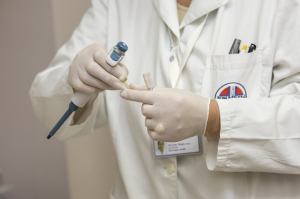
Neither the clinical researchers nor the patients know who is getting the active treatment and who is getting the placebo in a double-blind clinical trial.
Let’s take a couple of minutes and make sure that we know why we can allow ourselves to be impressed by the results of the Q-SYMBIO clinical trial (1), the KiSel-10 clinical trial (2), and the Morisco clinical trial (3).
The design of those clinical trials is the reason that we can trust the results.
All three of those CoQ10 trials were designed as randomized placebo-controlled double-blind studies. Intervention trials of this sort, with a placebo group as a control group, are the gold standard of bio-medical research.
What do we mean when we say randomized, placebo-controlled, and double-blind?
Two basic types of research
Basically, there are two types of bio-medical research: observational studies and experimental studies. The best (and most expensive) bio-medical studies are experimental studies in which participants in a treatment group (also called an intervention group) receive tablets or capsules containing the active ingredient that is being tested for safety or efficacy while participants in another group, called the control group, receive a placebo tablet or capsule that is as close as possible to the real thing in appearance, smell, and taste.
Randomization in studies of Q10
To avoid distortion of the trial results through selection bias or confounding bias, researchers randomly administer the active substance or the placebo substance to each one of the participants enrolled in the trial.
The theory is that, with a large enough sample and with random assignment, researchers will have formed a treatment group and a control group that are nearly identical with regard to all relevant parameters except for the taking of the active ingredient or the placebo ingredient.
If, then, at the end of the trial, there are differences in the results of the trial from one group to the other, the differences between the outcomes in the two groups are thought to be caused by the effect of the active ingredient.
Double blind studies involving Q10
Blinding of both the participants of the research and of the researchers themselves is done for the purpose of eliminating the possible effects of expectations on the part of the participants and on the part of the researchers.
No one knows, until the end of the trial when the code is unsealed, which participants were receiving which preparation, active or placebo. No one knows, in other words, who is in the active treatment group and who is in the placebo control group until the end of the trial.
Okay, yes, if the active ingredient, the CoQ10, is so effective that the trial participants who are getting it are looking stronger and more cheerful when they come in for check-ups and blood tests, then, of course, the researcher may think to himself that this participant is getting the CoQ10, but he won’t know for sure.
Proper Q10 clinical trial design
If the clinical trial is designed properly, we can assume that the trial has “internal validity,” that is to say, we can assume that the trial is, in fact, testing what we think that it is testing. In our case, we can assume that the researchers really were testing the efficacy of the Myoqinon/Bio-Quinone Q10 100 formulation used in the trials.
Given the solid design of the research, we think that the Q-SYMBIO trial and the KiSel-10 trial have yielded the results that they have because of the effect of the Pharma Nord preparation and not because of some other unaccounted for variable.
There is also something called “external validity,” which addresses the question of just how far the results of a clinical trial can be generalized to a broader community. For example, can results from male participants be generalized to females? Can results from one specific ethnic or racial group or from one specific age group be generalized to other groups? Researchers must be careful not to generalize too much.
Replications of Q10 heart failure trials
And, of course, we need replications of clinical trials to re-assure ourselves that the improvement in the condition of heart failure patients that we see does, in fact, occur again and again when the treatment with Q10 is given under similar circumstances.
Developing the rationale for the Q-SYMBIO study
In 2003, already, to develop a rationale for the multinational Q-SYMBIO clinical trial, Dr. Svend Aage Mortensen, a cardiologist at the Heart Centre at the Copenhagen University Hospital and the lead researcher in the Q-SYMBIO clinical trial, did a survey of published clinical trials testing the use of Q10 with heart failure patients.
Solid rationale for the Q-SYMBIO study
Dr.Mortensen found that, already to that point, researchers had conducted several double-blind placebo-controlled trials focusing on Q10 treatment for heart failure. The results in 10 out of 13 clinical trials, enrolling more than 1000 patients, had been positive and had shown statistically significant improvement in New York Heart Association class, in exercise capacity, and in reductions in the number of readmissions to the hospital. The outcomes in just 3 out of the 13 double-blind studies – equal to about 10% of the total number of patients treated with Q10—had been neutral.
Q10 in heart failure — statistically significant outcomes
If we are going to do a gold standard study, then we must have a placebo control group to compare with, we must have randomized assignment of patients to the placebo group and to the treatment groups, and we must have both the researchers and the patients kept blind to who is and who is not getting the active ingredient.
You may ask, well, how do the researchers know that the results are not just the results of chance? How do they know whether the results are statistically significant? I am going to address those questions in a separate article called Coenzyme Q10 and p-values and confidence intervals. And, then too, we might want to think about instances in which the results of a study might not make it over the line to be called statistically significant but nonetheless seem to be clinically significant.
Sources:
- Mortensen SA, Rosenfeldt F, Kumar A, et al. The Effect of Coenzyme Q10 on Morbidity and Mortality in Chronic Heart Failure: Results From Q-SYMBIO: A Randomized Double-Blind Trial. JCHF. 2014;():. doi:10.1016/j.jchf.2014.06.008.
- Alehagen, U., Johansson, P., Björnstedt, M., Rosén, A., & Dahlström, U. (2013). Cardiovascular mortality and N-terminal-proBNP reduced after combined selenium and coenzyme Q10 supplementation: a 5-year prospective randomized double-blind placebo-controlled trial among elderly Swedish citizens. International Journal Of Cardiology, 167(5), 1860-1866. doi:10.1016/j.ijcard.2012.04.156
- Morisco, C., Trimarco, B., & Condorelli, M. (1993). Effect of coenzyme Q10 therapy in patients with congestive heart failure: a long-term multicenter randomized study. The Clinical Investigator, 71(8 Suppl), S134-S136.
- Mortensen, S. A. (2003). Overview on coenzyme Q10 as adjunctive therapy in chronic heart failure. Rationale, design and end-points of “Q-symbio”–a multinational trial. Biofactors (Oxford, England), 18(1-4), 79-89.









[…] research results showing beneficial health effects – the Morisco study, the Q-Symbio study, the KiSel-10 study, and the Gulf War Veterans study – have all come from studies using the ubiquinone form of […]